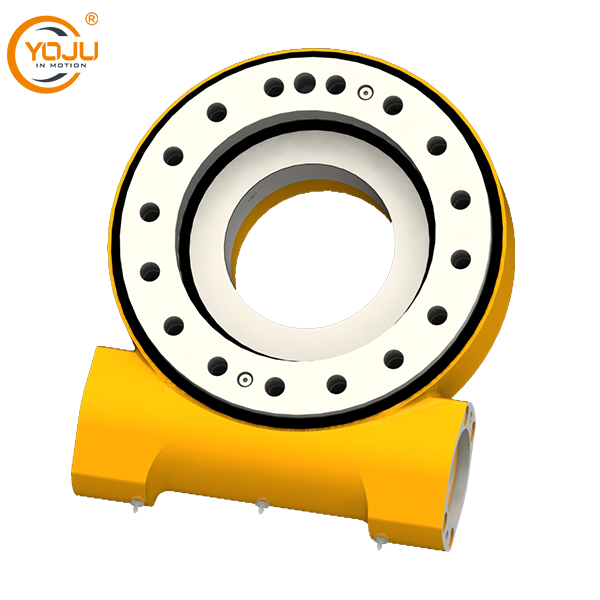In today’s construction and logistics industries, truck mounted cranes play a crucial role in handling heavy lifting tasks with mobility and efficiency. At the heart of these machines lies the slewing drive, a highly specialized rotational mechanism responsible for controlling the crane’s rotational movement. This component ensures smooth, stable, and precise operation even under substantial load conditions. In this blog post, YOJU, a slew drive for mechanical equipment manufacturer, will share the advantages of slewing drives in truck mounted cranes design, its applications, etc.
Understanding the Function of the Slewing Drive System
A slewing drive is a compact gearbox system that combines a worm gear mechanism with a slewing bearing to produce rotational motion. In truck mounted crane systems, this drive enables the upper structure of the crane—comprising the boom, operator’s cabin, and hydraulic components—to rotate 360 degrees or within a specific range, depending on design.
The slewing bearing handles axial, radial, and moment loads simultaneously, while the worm gear or planetary gear set transfers torque from the motor to achieve controlled motion. This design makes the slewing drive assembly exceptionally efficient in compact spaces, allowing truck cranes to perform heavy lifting with stability and precision, even on uneven surfaces.
Key Advantages of Slewing Drives in Truck Mounted Crane Design
High Torque and Load Capacity
Slewing drives are designed to transmit large torque within a small structure, making them ideal for truck mounted cranes that require compact yet powerful motion systems.
Compact and Integrated Structure
By combining a gearbox, motor, and bearing into a single unit, slewing drives minimize installation space and simplify mechanical design—an essential advantage for mobile cranes that prioritize weight efficiency and portability.
Enhanced Safety and Stability
The self-locking function of worm gear slewing drives ensures that the crane remains stable during lifting and when parked on slopes. This feature is critical for preventing unwanted rotation under load, ensuring operational safety.
Precise Positioning and Smooth Motion
Slewing drives provide fine control over rotational speed and angle, enabling operators to position loads accurately. This precision enhances efficiency during material handling and assembly tasks.

Types of Slewing Drives Used in Truck Mounted Cranes
Different types of slewing drive systems are employed depending on crane capacity, rotation requirements, and environmental conditions:
-
Worm Gear Slewing Drive – Offers self-locking capability and is ideal for smaller truck cranes needing high stability and safety.
-
Planetary Gear Slewing Drive – Delivers higher transmission efficiency and is suitable for large truck mounted cranes requiring faster rotational speeds.
-
Hydraulic Slewing Drive – Uses hydraulic power for heavy-duty cranes, providing high torque and consistent motion control under demanding load conditions.
-
Electric Slewing Drive – Common in modern, energy-efficient cranes, offering precise electronic control and simplified maintenance.
Each configuration ensures that the slewing mechanism meets specific application requirements, balancing torque output, rotation accuracy, and energy efficiency.
Applications and Integration in Truck Mounted Cranes
The slewing drive unit is typically installed between the truck chassis and the crane’s superstructure. This strategic placement allows the boom to rotate freely while maintaining full structural balance. Some notable applications include:
-
Urban Construction and Maintenance – Compact slewing drives support cranes working in limited spaces, allowing precise maneuvering near buildings or utility poles.
-
Logistics and Port Handling – High-torque drives enhance rotation stability for loading and unloading operations on uneven terrain or moving platforms.
-
Rescue and Utility Services – Quick and safe rotation helps emergency and maintenance vehicles operate efficiently in time-sensitive environments.
-
Wind Power and Infrastructure Projects – Heavy-duty slewing drives are integrated into truck cranes that assist in lifting components like wind turbine blades and bridge sections.
These applications illustrate the versatility and indispensable nature of slewing drives in mobile crane systems across industries.
Innovation Trends in Slewing Drive Technology
Recent technological developments have significantly improved slewing drive performance for truck mounted cranes. Manufacturers now focus on:
-
Lightweight Materials and Compact Design – Advanced alloys and structural optimization reduce overall weight without sacrificing strength.
-
Improved Sealing and Lubrication Systems – Enhanced protection against dust, moisture, and corrosion extends service life and reduces maintenance frequency.
-
Integrated Sensors and IoT Monitoring – Smart slewing drives can monitor torque, temperature, and vibration in real time, supporting predictive maintenance and enhancing safety.
-
Hybrid Power Compatibility – Electric and hybrid truck cranes increasingly adopt electromechanical slewing drives, reducing fuel consumption and environmental impact.
These innovations contribute to greater efficiency, safety, and sustainability—key factors in the evolution of modern truck mounted crane systems.
Maintenance and Operational Considerations
To ensure long-term reliability, slewing drive systems require proper maintenance and periodic inspection. Essential practices include:
-
Regular Lubrication: Maintaining appropriate lubricant levels prevents wear between gear teeth and bearing races.
-
Torque Monitoring: Over-torque conditions should be avoided to prevent gear damage and misalignment.
-
Seal Inspection: Damaged seals can lead to lubricant leakage and contamination, reducing operational life.
-
Mounting Bolt Check: Ensuring that all bolts are tightened to specified torque values maintains structural integrity and safety.
Consistent maintenance not only extends the life of the slewing drive but also guarantees the overall performance of the truck crane.
Conclusion
The integration of slewing drives in truck mounted cranes represents a perfect synergy of precision engineering and practical functionality. These drives enable cranes to operate safely, efficiently, and flexibly across various terrains and working conditions. As technology continues to advance, slewing drive systems will play an even greater role in shaping the next generation of intelligent, energy-efficient, and high-performance mobile lifting machinery.
For manufacturers, engineers, and operators alike, investing in high-quality slewing drive solutions is not merely a technical choice—it is a commitment to reliability, innovation, and long-term productivity in every lifting operation.
www.enyoju.com
YOJU